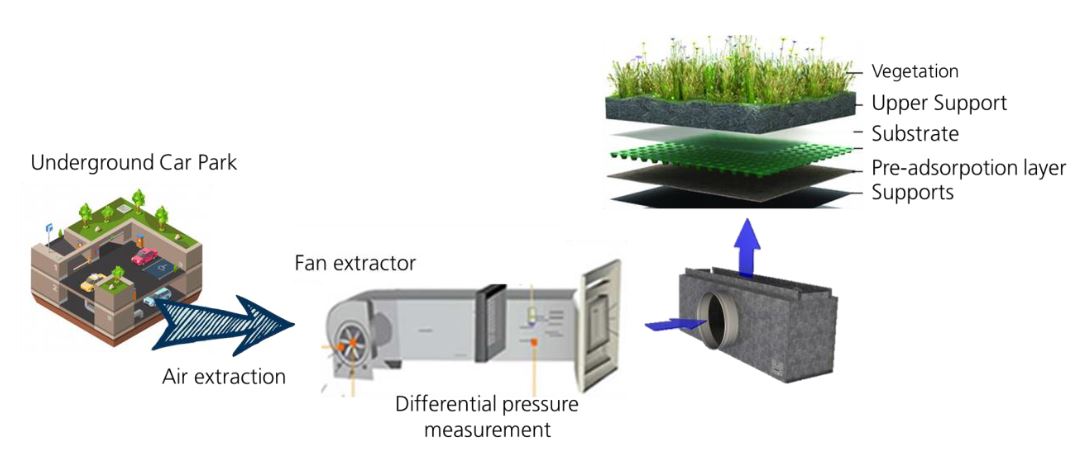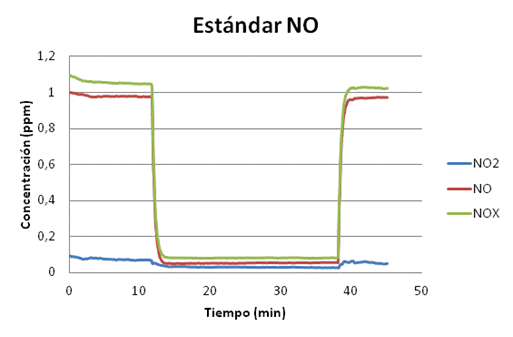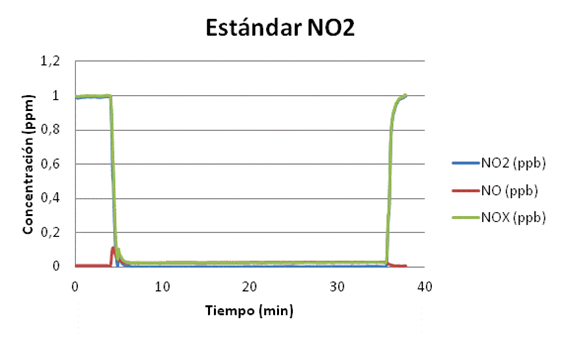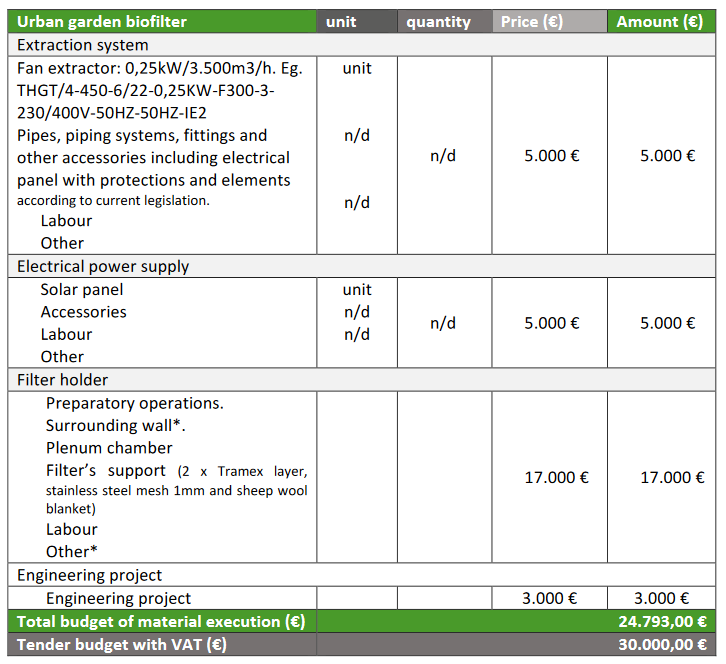Urban Garden Biofilter is an air filter framed in an urban garden to reduce the emissions of underground car parks or other stationary sources of pollutant compounds in urban environments. This NBS can be adapted to existing car parks or tunnels, or included in the design of new infrastructures.

Urban garden bio-filter, URBAN GreenUP project
It is composed of three main elements:
- the extractor system to extract the polluted air from underground areas/ car parks;
- the plenum section to distribute the air under the Biofilter and
- the Biofilter itself to clean the air and metabolize pollutants.
The Urban Garden Biofilter captures most of NOX and PM (>90%) from indoor air (pollutants concentration 0.5-1 ppm)
Urban garden biofilters for air pollution have a high impact on health due to the improved air quality.
Biofilters will also promote a greater biodiversity. They have a direct impact on the increase in species and pollinators, support the increase of ecological connectivity and contributes to more collaboration and green awareness. In addition, biofilters will reduce the risk of epidemics and the ecological footprint.
URBAN Garden Biofilter is proposed to extract a controlled and small flow of air continuously and pass it through the soil of the garden in which the biofilter is integrated. The biofilter is composed of a series of layers that sequentially capture the main pollutants present in the combustion gases that reduce urban air quality, nitrogen oxides and particulate matter. The top layer of the biofilter is a high porosity substrate that is maintained at low humidity levels and in which a series of native species with low water requirements are planted and no large roots as these could damage the filter.
Climate and Geography:
The urban garden bio-filter can be placed in any smoke extraction, especially from vehicles, heaters and other infrastructures as filter framed in an urban garden of pollutants in urban environments. The biofilter is divided in three parts, the most sensitive part to Climate and Geography are layers for support, pollutants absorption and protection and the vegetation which covers these layers. The main reason is the outdoor location of this Nature Based Solution (NBS), it is designed to withstand a certain amount of water, so that it does not damage the smoke extraction system as excessive daily irrigation or high rainfall over a long period of time can flood the system.
Therefore, irrigation of the selected species will be shallow and weekly with native species adapted to the requirements imposed.

Urban Garden Bio-filter front view (Source: CARTIF)
Urban Form and layout & Technical aspects/infrastructure:
Inside tunnels and car parks, combustion gases are confined and accumulate. These are eventually emitted to the outside world through the entrances and exits of the car parks as well as through the extraction towers.
The system is going to be installed next to one of the indoor air exit areas of the underground car park and must be dimensioned proportionally to the amount of flow to be filtered, as well as to hide within the structure of all the components
Policy and regulatory/legal framework:
The construction of this NBS must meet planning and safety criteria.
Funding and financing & Economic and social context:
This action could be led from different municipality areas (at least urbanism, environment and heritage).
Also, by private funds that have car park property, construction companies
Project governance and implementation modalities:
It would be interesting if the municipalities made it compulsory for all public car parks and private car parks with a certain volume of vehicles and plants to install this NBS. In addition to boiler outlets in public centres, ventilation outlets in tunnels and underground railways.
The main difficult aspect is found in the design and project phase for the implementation of this NBS. Problems with the exact location of the smoke outlet, dimensions, it would have been easier to build the URBAN BioFilter in parallel to the construction of the car park.
Impact assessment can be carried out by using one or several of the indicators depending on the budget or monitoring tool available.
Monitoring locations should be done by experts for the first studies because this is an innovative solution.
Climate and Geography:
There are some operational and maintenance considerations (this action is usually done by the gardening team in charge of the area):
- Vegetation and soil manage.
- Visual supervision monthly.
- Soil aeration bi-annual.
- Weekly watering in summer time (out of this period only in case if dry season).
Extraction installation (Operation to be carried out by the extraction system installer during at least the two first years.)
- Annual maintenance (according to the installation manual)
- Differential pressure supervision constantly.
- Urban Garden Bio-Filter (URBAN GreenUP project)
- Evaluating the Impact of Nature-based Solutions: A Handbook for Practitioners [Page 225]
AIR QUALITY Indicators:
Annual mean levels of fine pm2.5 particles
- KPI definition: Annual mean levels of fine (PM2.5) particulate matter in cities concentration recorded ug/m3. Unit: PM2.5 μg/m3
- Measured method: A portable photometric sampler designed to measure ambient PM2.5 and PM10 concentrations. This KPI requires a portable monitor because the quite big measurement points.
Annual mean levels of fine pm10 particles
- KPI definition: Annual mean levels of fine (PM10) particulate matter in cities concentration recorded ug/m3. Unit: PM10 μg/m3
- Measured method: A portable photometric sampler designed to measure ambient PM2.5 and PM10 concentrations. This KPI requires a portable monitor because the quite big measurement points.
Air quality monetary values
- KPI definition: Value of air pollution reduction. Unit: €/$...
- Measured method: City official data plus city platforms and surveys by questionnaires and small- medium enterprise accounts
DNSH:
Climate change adaptation
This NBS helps to reduce particulate pollutants in the air.
Sustainable use and protection of water and marine resources
As the number of particles in the air is reduced, they will also be reduced in the rainwater that carries particles from the air.
Pollution prevention and control
This NBS helps to reduce particulate pollutants in the air.
The protection and restoration of biodiversity and ecosystems
Plants have several layers of substrate and plants that fix and keep the substrate aerated by exploring it with their roots, allowing microorganisms to live in the soil and, as they are native plants, they will also help pollinators to feed, helping urban biodiversity
- Educational Activities on NBS: https://netzerocities.app/resource-1518
- Capacity building for city officials to understand urban metabolisms and circular solution opportunities https://netzerocities.app/resource-1568
- Engagement, co-creation and co-design of NBS and Green Infrastructure plans and interventions https://netzerocities.app/resource-1608
- Integrated land use and urban planning with energy and climate https://netzerocities.app/resource-1678
- Integrated climate plans for cities (i.e.: SECAPs) https://netzerocities.app/resource-1698
- Decarbonisation Plans for Industry https://netzerocities.app/resource-1718
- Governance EU Climate Neutrality Framework https://netzerocities.app/resource-1728
- Public procurement for innovative NBS and Green Infrastructure interventions https://netzerocities.app/resource-588
- NBS and Green Infrastructure regulation and ordinances https://netzerocities.app/resource-1813
URBAN GreenUP adsorbent material (thickness 5 cm). This material must be able to adsorb at least 2.72-10-3 mg NO/min/m2 (result based on laboratory test using a flow rate of 3L/min of air with 1 ppm NO under normal conditions, see graph below).

Standard concentrations. Source: URBAN GreenUP
URBAN GreenUP fibrous material (thickness 5 cm when spreading). Material of natural origin consisting of non-braided fibres that is a by-product of processes that take place within 250 km. A suitable material would be the by-product of the wool washing and combing industry.
URBAN GreenUP vegetal substrate (thickness 35 cm). This material must be able to adsorb at least 4.16-10-3 mg NO2/min/m2 (result based on laboratory test using a flow rate of 3L/min of air with 1 ppm NO2 under normal conditions (see graph below).


Comments ()